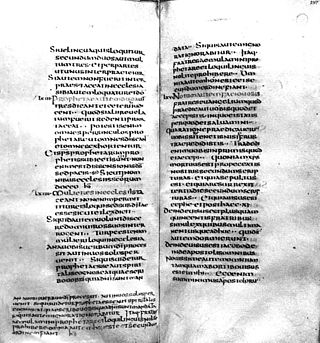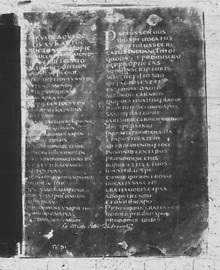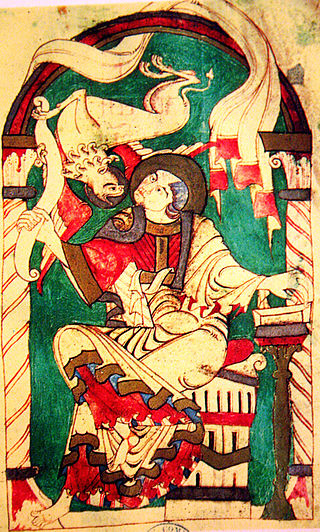
The Vulgate, sometimes referred to as the Latin Vulgate, is a late-4th-century Latin translation of the Bible.

Textus Receptus refers to the succession of printed editions of the Greek New Testament from Erasmus's Novum Instrumentum omne (1516) to the 1633 Elzevir edition.
The Johannine Comma is an interpolated phrase (comma) in verses 5:7–8 of the First Epistle of John.

The Codex Amiatinus is considered the best-preserved manuscript of the Latin Vulgate version of the Christian Bible. It was produced around 700 in the northeast of England, at the Benedictine Monkwearmouth–Jarrow Abbey in the Kingdom of Northumbria, now South Tyneside, and taken to Italy as a gift for Pope Gregory II in 716. It was one of three giant single-volume Bibles then made at Monkwearmouth–Jarrow, and is the earliest complete one-volume Latin Bible to survive, only the León palimpsest being older. It is the oldest Bible where all the biblical canon present what would be their Vulgate texts.

The Codex Fuldensis, also known as the Victor Codex, designated by F, is a New Testament manuscript based on the Latin Vulgate made between 541 and 546. The codex is considered the second most important witness to the Vulgate text; and is also the oldest complete manuscript witness to the order of the Diatessaron. It is an important witness in any discussion about the authenticity of 1 Corinthians 14:34–35 and the Comma Johanneum. It is one of the earliest dated manuscripts of the New Testament. It was corrected until 2 May, 546 AD.

The La Cava Bible or Codex Cavensis is a 9th-century Latin illuminated Bible, which was produced in Spain, probably in the Kingdom of Asturias during the reign of Alfonso II. The manuscript is preserved at the abbey of La Trinità della Cava, near Cava de' Tirreni in Campania, Italy, and contains 330 vellum folios which measure 320 by 260 mm.

Codex Sangermanensis designated by Dabs1 or 0319, α 1027 (Soden), is a tenth-century diglot manuscript, formerly in the library of St. Germain des Prés, Paris, hence its name Sangermanensis, "of Saint Germanus". Now it is preserved in the Bibliothèque nationale, Number 11105 Fonds Latin. It contains the Pauline Epistles, lacking most of 1 Timothy and parts of Romans and Hebrews. It is particularly notable as one of the two such copies which display clear evidence of having had Claromontanus as exemplar. It is now part of the National Library of Russia collection in Saint Petersburg.

Codex Vaticanus, designated by S or 028, ε 1027, formerly called Codex Guelpherbytanus, is a Greek manuscript of the four Gospels which can be dated to a specific year instead of an estimated range. The colophon of the codex lists the date as 949. This manuscript is one of the four oldest New Testament manuscripts dated in this manner, and the only dated uncial.

Codex Angelicus designated by Lap or 020, α 5, is a Greek uncial manuscript of the New Testament. Palaeographically it has been assigned to the 9th century. Formerly it was known as Codex Passionei.

Novum Instrumentum Omne, later called Novum Testamentum Omne, was a bilingual Latin-Greek New Testament with scholarly annotations, and the first printed New Testament of the Greek to be published. It was prepared by Desiderius Erasmus (1466–1536) and printed by Johann Froben (1460–1527) of Basel.

The Codex Corbeiensis I, designated by ff1 or 9, is an 8th, 9th, or 10th-century Latin New Testament manuscript. The text, written on vellum, is a version of the old Latin. The manuscript contains 39 parchment folios with the text of the four Gospels, Acts of the Apostles, and General epistles.

The Codex Frisingensis, designated by r and q or 64, is a 6th or 7th century Latin manuscript of the New Testament. The text, written on vellum, is a version of the old Latin. The manuscript contains the text of the Pauline epistles with numerous lacunae on only 26 parchment leaves.
The Codex Sangermanensis I, designated by g1 or 7, is a Latin manuscript, dated AD 822 of portions of the Old Testament and the New Testament. The text, written on vellum, is a version of the Latin. The manuscript contains the Vulgate Bible, on 191 leaves of which, in the New Testament, the Gospel of Matthew contain Old Latin readings. It contains Shepherd of Hermas.
The Codex Complutensis I, designated by C, is a 10th-century codex of the Christian Bible. It is written on vellum with Latin text mainly following the Vulgate. Parts of the Old Testament present an Old Latin version.
Minuscule 627, α 53, is a Greek minuscule manuscript of the New Testament, on parchment. Palaeographically it has been assigned to the 10th century. The manuscript is lacunose. Tischendorf labelled it by 160a, 193p, and 24r. It has unusual order of books: the Book of Revelation is placed between Book of Acts and the Catholic epistles.
Minuscule 629, α 460, is a Latin–Greek diglot minuscule manuscript of the New Testament, on parchment. It is known as Codex Ottobonianus. Palaeographically it has been assigned to the 14th century. The manuscript is lacunose. It is known for the Comma Johanneum.
The Codex Theodulphianus, designated Θ, is a 10th-century Latin manuscript of the Old and New Testament. The text, written on vellum, is a version of the Latin Vulgate Bible. It contains the whole Bible, with some parts written on purple vellum.
The León Palimpsest, designated l or 67, is a 7th-century Latin manuscript pandect of the Christian Bible conserved in the cathedral of León, Spain. The text, written on vellum, is in a fragmentary condition. In some parts it represents the Old Latin version, while following Jerome's Vulgate in others. The codex is a palimpsest.

The Codex Sangallensis 63, designated by S in some critical editions of the Bible, is a 9th-century Latin manuscript of the New Testament. The text, written on vellum, is a version of the Vulgate and contains the text of the Acts of the Apostles, Epistles, Book of Revelation, and non-biblical material. The manuscript has not survived in a complete condition, some parts of it have been lost. The original manuscript did not contain the Comma Johanneum, but it was added by a later hand on the margin.

The Codex Sangallensis 907, designated S, is an 8th-century Latin manuscript of the New Testament. The text, written on vellum, is a version of the Latin Vulgate Bible. It contains the text of the Catholic epistles, Book of Revelation, and non-biblical material. The manuscript did not survived in a complete condition and some parts of it has been lost. The codex contains the Comma Johanneum.












